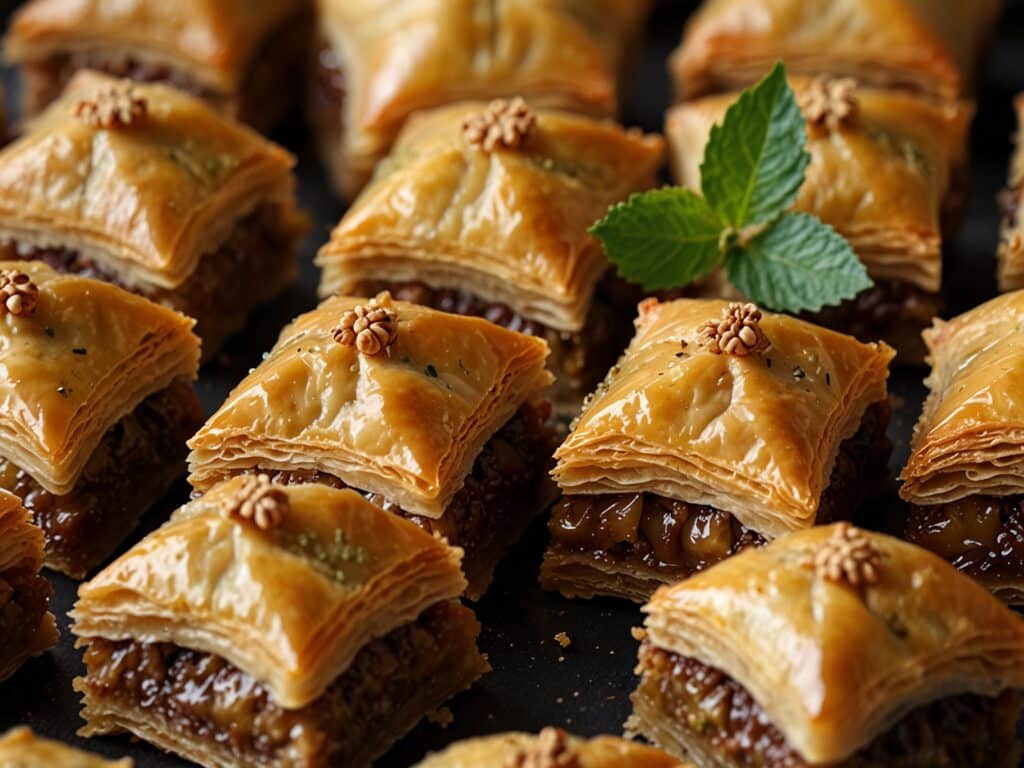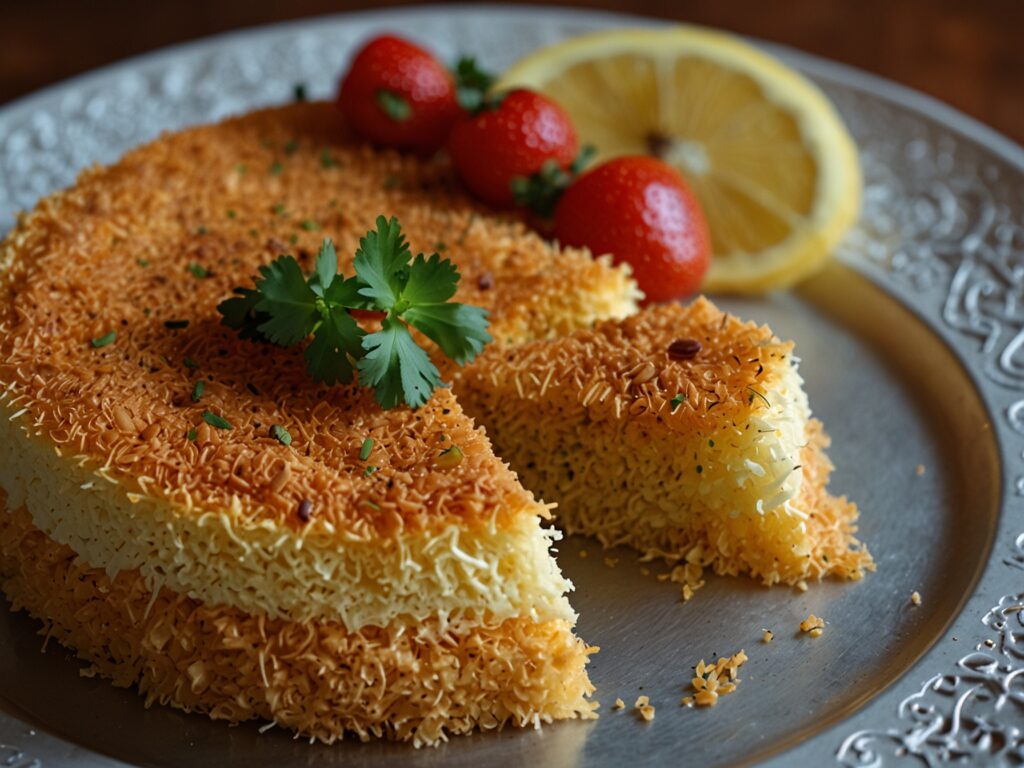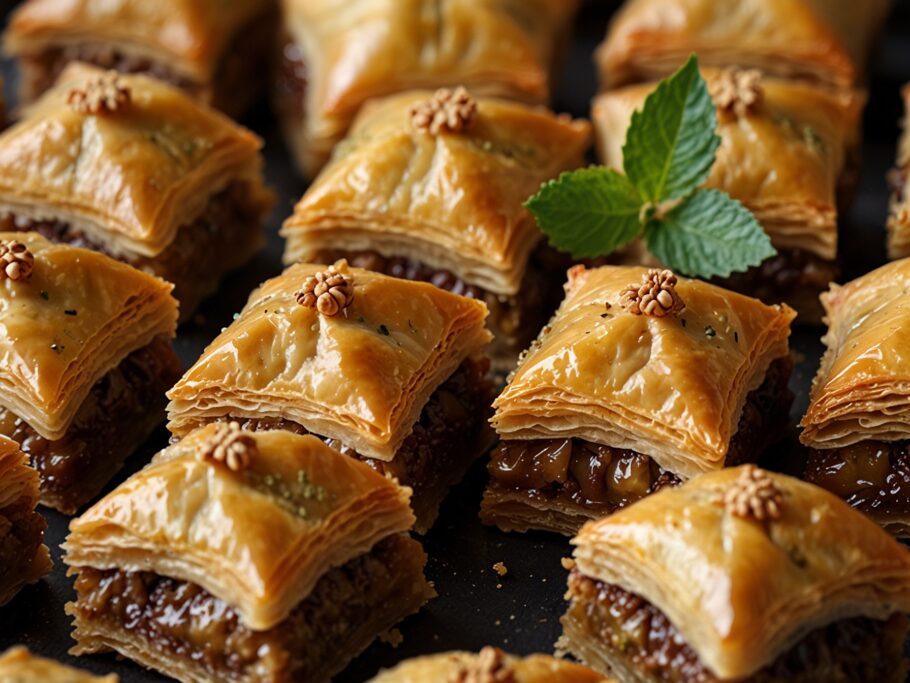 Add to Recipe Book
Add to Recipe BookThe Middle East boasts a rich tapestry of flavors, colors, and aromas that define its culinary landscape. Middle Eastern sweets, in particular, have a long and storied history that reflects the region’s diverse cultural influences and historical events. From the bustling bazaars of Istanbul to the tranquil cafes of Beirut, these desserts are more than just treats—they are symbols of hospitality, celebration, and tradition.
The origins of Middle Eastern sweets are intertwined with the region’s complex history. These sweets have been shaped by various civilizations, including the Persians, Greeks, Romans, and Ottomans. Each of these cultures contributed unique ingredients, techniques, and recipes that have evolved into the beloved desserts we enjoy today. The evolution of these sweets is a testament to the region’s rich cultural exchange and its ability to adapt and innovate over centuries.
The Cultural Significance of Middle Eastern Sweets
Middle Eastern sweets are integral to the region’s cultural and social fabric. They are often associated with significant life events and religious celebrations, underscoring their importance beyond mere culinary delight.
Celebratory Occasions
Sweets are a staple at various celebrations, including weddings, births, and religious festivals like Ramadan and Eid. During Ramadan, for example, families break their fast with an array of sweets that provide a quick source of energy and comfort after a day of fasting. The sharing of sweets during these times symbolizes community, generosity, and joy.
Traditional Ingredients
The ingredients used in Middle Eastern sweets are as diverse as the region itself, reflecting local agricultural practices and trade influences.
Common Components
Key ingredients include honey, dates, nuts (such as pistachios, almonds, and walnuts), and spices like cinnamon and cardamom. These components not only enhance the flavor but also offer a glimpse into the region’s agricultural bounty and trade history. Rose water and orange blossom water are also frequently used, imparting a distinctive floral aroma that is synonymous with Middle Eastern desserts.
Evolution of Middle Eastern Sweets
The journey of Middle Eastern sweets from ancient times to the present day is a fascinating tale of adaptation and innovation.
Ancient to Modern Times
In ancient Persia, sweet-making was an art form, and recipes were closely guarded secrets. As empires rose and fell, the exchange of culinary knowledge became inevitable. The Greeks and Romans, for example, introduced new techniques and ingredients, while the Ottomans, with their vast empire, further enriched the repertoire of Middle Eastern sweets. Modern times have seen these traditional recipes adapted to contemporary tastes, incorporating global influences while maintaining their authentic essence.
Influences from Ancient Civilizations
The Middle East has been a melting pot of civilizations, each leaving its mark on the region’s culinary traditions.
Persian, Greek, and Roman Contributions
Persian cuisine, renowned for its use of sugar and nuts, significantly influenced the development of Middle Eastern sweets. The Greeks introduced phyllo pastry, which is now a fundamental component of many desserts like baklava. The Romans contributed by popularizing the use of honey as a sweetener. These ancient civilizations laid the groundwork for the rich and diverse array of sweets that we associate with the Middle East today.
Role of Trade Routes
The strategic location of the Middle East made it a crucial hub for trade routes, including the Silk Road and the spice trade, which brought an influx of exotic ingredients and culinary techniques.
Silk Road and Spice Trade
The Silk Road connected the East and West, facilitating the exchange of goods, ideas, and culinary practices. Spices like saffron, cardamom, and cinnamon, which are now integral to Middle Eastern sweets, were introduced through these trade routes. The spice trade also brought new methods of preserving and enhancing the flavors of sweets, enriching the region’s culinary landscape.
Impact of Religious Practices
Religion has played a significant role in shaping the customs and traditions surrounding Middle Eastern sweets.
Ramadan and Other Festivities
During Ramadan, the consumption of sweets increases significantly. Special desserts like qatayef, a type of stuffed pancake, are prepared exclusively for this holy month. Eid al-Fitr, marking the end of Ramadan, is celebrated with an array of sweets that vary from one country to another. These religious practices have cemented the role of sweets in cultural and familial rituals, making them an indispensable part of Middle Eastern heritage.
Decadent Delights: Popular Middle Eastern Sweets
The array of Middle Eastern sweets is vast, each with its unique flavor profile and cultural significance.
Baklava, Kunafa, and More
Baklava is perhaps the most well-known Middle Eastern sweet, consisting of layers of phyllo pastry filled with nuts and soaked in syrup. Kunafa, another favorite, is made with shredded phyllo dough or semolina, layered with cheese or cream, and drizzled with syrup. Other popular sweets include halva, ma’amoul (stuffed shortbread cookies), and basbousa (semolina cake soaked in syrup). Each of these sweets has its own story and regional variations, making them a delightful exploration of Middle Eastern culture.
The Art of Making Baklava

Baklava is not just a dessert; it’s a culinary masterpiece that requires precision and skill.
Techniques and Traditions
The process of making baklava involves layering thin sheets of phyllo dough with a mixture of finely chopped nuts and spices. The layers are then drenched in a syrup made of honey or sugar and flavored with rose water or orange blossom water. The final product is baked to golden perfection, resulting in a dessert that is both crispy and sweet. Traditional techniques often passed down through generations, ensure that each piece of baklava maintains its authentic flavor and texture.
Kunafa: A Sweet with a Twist

Kunafa is a versatile dessert with numerous regional variations, each offering a unique twist on this classic sweet.
Variations Across the Region
In Lebanon, kunafa is typically made with semolina dough and filled with a sweet cheese like akkawi. In Palestine, it’s often prepared with shredded phyllo dough and a filling of sweetened cheese or cream. The dessert is then soaked in a fragrant sugar syrup, which is sometimes tinted with food coloring for a vibrant appearance. These variations reflect the diverse culinary traditions within the Middle East, showcasing the creativity and adaptability of its people.
Dark Origins: The Slave Trade’s Impact
The history of Middle Eastern sweets is not without its darker chapters. The region’s involvement in the slave trade had a profound impact on its culinary traditions.
Historical Context
During the height of the Ottoman Empire, slaves were often used in the kitchens of the elite to prepare elaborate feasts. These slaves, brought from various parts of Africa and Asia, introduced new ingredients and cooking techniques that influenced the development of Middle Eastern sweets. While the contributions of these enslaved individuals enriched the region’s culinary heritage, it is a sobering reminder of the human cost behind these beloved treats.
Culinary Influence of Conquerors
The Middle East’s tumultuous history of conquest and colonization has left an indelible mark on its cuisine.
Ottoman Empire and Beyond
The Ottomans, with their vast empire spanning Europe, Asia, and Africa, brought together a diverse array of culinary traditions. This blending of cultures resulted in a rich and varied repertoire of sweets that incorporated elements from the Balkans, the Mediterranean, and the Arabian Peninsula. The influence of these conquerors is evident in the region’s desserts, which often feature a fusion of flavors and techniques from different parts of the empire.
Economic Factors and Sweet Production
Economic conditions have also played a crucial role in the production and consumption of Middle Eastern sweets.
Historical Economic Drivers
The prosperity of trade routes like the Silk Road allowed for the widespread availability of luxury ingredients such as sugar, nuts, and spices. In times of economic hardship, sweets became simpler, relying on locally available ingredients. The fluctuation of these economic conditions is reflected in the evolution of Middle Eastern sweets, highlighting their adaptability and resilience.
Social Hierarchies and Sweet Consumption
The consumption of sweets in the Middle East has historically been influenced by social hierarchies and class distinctions.
Class Distinctions
In the past, elaborate sweets made with expensive ingredients were reserved for the wealthy elite, while simpler desserts were consumed by the lower classes. This disparity is evident in the preparation and presentation of sweets, with intricate designs and luxurious ingredients often signifying higher social status. Today, while these distinctions have diminished, the tradition of offering sweets as a sign of hospitality and generosity remains a cornerstone of Middle Eastern culture.
Modern Adaptations of Traditional Sweets
As global culinary trends evolve, so too do the traditional sweets of the Middle East.
Fusion and Innovation
Contemporary chefs are experimenting with traditional recipes, incorporating elements from other cuisines to create innovative desserts. For example, baklava cheesecake and kunafa ice cream have become popular variations, blending the old with the new. These modern adaptations ensure that Middle Eastern sweets remain relevant and appealing to new generations, while still honoring their rich heritage.
Health Implications
While delicious, Middle Eastern sweets are often high in sugar and calories, raising concerns about their health implications.
Sugar and Caloric Content
The high sugar content in many Middle Eastern sweets can contribute to health issues such as diabetes and obesity if consumed in excess. However, these desserts can be enjoyed in moderation as part of a balanced diet. Some modern recipes are also being adapted to reduce sugar and incorporate healthier ingredients, offering a more nutritious take on traditional favorites.
Middle Eastern Sweets in Global Cuisine
The popularity of Middle Eastern sweets has transcended regional boundaries, making them a beloved part of global cuisine.
Popularity and Adaptation Worldwide
In recent years, Middle Eastern sweets have gained international recognition, with bakeries and restaurants around the world offering these delightful treats. The global food scene has embraced the unique flavors and textures of Middle Eastern desserts, often adapting them to suit local tastes while maintaining their authentic essence.
Preservation of Traditional Recipes
Efforts are being made to preserve the traditional recipes and techniques that define Middle Eastern sweets.
Efforts to Maintain Authenticity
Organizations and culinary historians are working to document and protect the traditional methods of making Middle Eastern sweets. These efforts ensure that future generations can continue to enjoy and appreciate the authentic flavors and cultural significance of these desserts. Cooking classes and workshops are also being offered to teach people how to prepare these sweets at home, fostering a deeper connection to the region’s culinary heritage.
The Role of Women in Sweet Production
Women have historically played a crucial role in the production of Middle Eastern sweets, both in the home and in commercial settings.
Historical and Modern Perspectives
Traditionally, the preparation of sweets was often a communal activity among women, who would gather to make large quantities for special occasions. Today, many women continue to be involved in the production of sweets, running successful businesses and passing down their knowledge to younger generations. This tradition highlights the important role of women in preserving and perpetuating the culinary heritage of the Middle East.
Middle Eastern Sweets in Literature and Art
The cultural significance of Middle Eastern sweets is also reflected in literature and art, where they are often depicted as symbols of hospitality and celebration.
Cultural Depictions
From ancient poetry to modern novels, Middle Eastern sweets have been celebrated in literary works for their sensory appeal and cultural symbolism. Artistic representations, such as paintings and illustrations, often feature these desserts as central elements in scenes of feasting and festivity. These depictions underscore the deep-rooted connection between Middle Eastern sweets and the region’s cultural identity.
Regional Variations and Specialties
Each region within the Middle East has its own unique take on traditional sweets, resulting in a diverse array of flavors and textures.
Distinctive Local Flavors
For example, Turkish delight (lokum) is a popular sweet in Turkey, known for its chewy texture and variety of flavors. In Lebanon, baklava is often made with a combination of pistachios and walnuts, while in Iran, it may include rose water and saffron. These regional variations highlight the richness and diversity of Middle Eastern cuisine, offering a delightful exploration of local flavors and culinary traditions.
Sweet Shops and Markets
To experience the full range of Middle Eastern sweets, a visit to local sweet shops and markets is a must.
Where to Find the Best Treats
From the bustling bazaars of Istanbul to the quaint pastry shops of Amman, these establishments offer a wide selection of freshly made sweets. Markets, in particular, provide an immersive experience, allowing visitors to sample a variety of treats while soaking in the vibrant atmosphere. These places not only offer delicious desserts but also a glimpse into the region’s rich culinary heritage.
The Future of Middle Eastern Sweets
As culinary trends continue to evolve, the future of Middle Eastern sweets looks promising.
Trends and Predictions
With a growing interest in global cuisines, Middle Eastern sweets are likely to gain even more popularity. Innovations in food technology and sustainability practices will also influence the production of these sweets, ensuring that they remain relevant and environmentally friendly. The future of Middle Eastern sweets lies in a delicate balance between preserving tradition and embracing modernity, promising a continued legacy of delightful flavors and cultural significance.
Recipes to Try at Home
For those looking to experience the magic of Middle Eastern sweets in their own kitchen, there are plenty of recipes to try.
Authentic and Modern Takes
From classic baklava to modern kunafa cheesecake, these recipes offer a chance to recreate the beloved flavors of the Middle East at home. By following traditional techniques and using authentic ingredients, home cooks can enjoy the satisfaction of making these delicious desserts themselves. Modern adaptations also provide opportunities to experiment with new flavors and presentations, adding a personal touch to these time-honored treats.
Sustainability and Ethical Considerations
In today’s world, sustainability and ethical considerations are becoming increasingly important in the production of food, including Middle Eastern sweets.
Modern Challenges
The use of locally sourced ingredients and environmentally friendly practices can help ensure that the production of these sweets is sustainable. Additionally, fair trade practices and ethical sourcing of ingredients, such as nuts and spices, are crucial in supporting the livelihoods of farmers and communities involved in their cultivation. By prioritizing sustainability and ethics, the tradition of Middle Eastern sweets can be preserved for future generations in a responsible and equitable manner.
Personal Reflections and Experiences
Middle Eastern sweets hold a special place in the hearts of many, often evoking cherished memories and personal experiences.
Anecdotes and Memories
For those who have grown up in the Middle East or have had the opportunity to visit, the taste of these sweets can bring back fond memories of family gatherings, celebrations, and the warmth of shared moments. Personal anecdotes and stories add a human touch to the rich history of these desserts, highlighting their role in creating lasting bonds and joyful experiences.
Middle Eastern Sweets
Middle Eastern sweets are more than just culinary delights; they are a reflection of the region’s rich history, diverse cultures, and enduring traditions. From the ancient influences of Persia, Greece, and Rome to the modern innovations of today, these sweets have evolved into a beloved part of the Middle East’s culinary heritage. Despite their often dark origins, they continue to bring joy and celebration to people around the world. Whether enjoyed at a festive gathering or as a simple treat, Middle Eastern sweets offer a taste of the region’s vibrant and multifaceted identity.
FAQs
How did the slave trade impact the development of Middle Eastern sweets?
The slave trade brought new ingredients and culinary techniques to the Middle East, influencing the development of sweets. Slaves from Africa and Asia introduced various flavors and methods that enriched the region’s culinary traditions.
What are some common ingredients in Middle Eastern sweets?
Common ingredients include honey, dates, nuts (such as pistachios, almonds, and walnuts), spices like cinnamon and cardamom, and floral waters such as rose water and orange blossom water.
How are Middle Eastern sweets typically consumed?
Middle Eastern sweets are often consumed during celebrations and religious festivals. They are also enjoyed as a treat with tea or coffee, symbolizing hospitality and generosity.
What are some popular Middle Eastern sweets?
Popular Middle Eastern sweets include baklava, kunafa, halva, ma’amoul, and basbousa. Each of these desserts has its own unique flavor profile and cultural significance.
How have modern adaptations influenced traditional Middle Eastern sweets?
Modern adaptations have introduced new flavors and techniques to traditional Middle Eastern sweets, such as baklava cheesecake and kunafa ice cream. These innovations help keep the desserts relevant and appealing to new generations.
Why is the preservation of traditional recipes important?
Preserving traditional recipes ensures that the authentic flavors and cultural significance of Middle Eastern sweets are maintained for future generations. It also helps keep culinary heritage alive and fosters a deeper connection to the region’s history and culture.
Conclusion
Middle Eastern sweets, with their intricate flavors and rich history, are a testament to the region’s cultural heritage and culinary prowess. Despite their often dark origins, these desserts continue to be a source of joy and celebration, transcending regional boundaries and captivating taste buds around the world. As we look to the future, the preservation and adaptation of these sweets will ensure that they remain a cherished part of global cuisine, celebrating the vibrant and diverse legacy of the Middle East.





